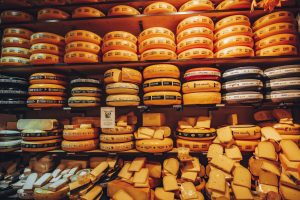Say “Cheese” … and All About It! If you want to stay healthy and active, you need to have it regularly. It strengthens your muscles and is easy to digest.
Key Benefits of Cheese
Cheese is full of calcium as milk is its main ingredient. Calcium, as we all know, is a great need for our bones and muscles. It helps us have vitamins like A, K, and D, which are necessarily important to our bone health. It also helps us with inflammation. There is less inflammation in people who use cheese regularly. It is a fantastic meal for those who have high blood pressure issues. Research done by dental professionals tells us that cheese can help you keep your teeth healthier. If you are skinny or want to gain weight, cheese is the ultimate solution for you.
Cheesemaking as a Business Idea
The art of making cheese, known scientifically as caseiculture, has been around for thousands of years, and cheese farming is a very profitable and lucrative business today. People have started farming for this business, where they keep cows, goats, and buffalos to increase their productivity. If you want to start this business, don’t be late and start as soon as it gets. It is a huge business that has excessive income.
A little History
Records show that even the ancient Egyptians partook in this practice. Cheesemaking is hypothesized to have emerged from the practices of nomadic herdsmen. When stored in containers made of sheep or goat stomachs, milk ferments from both wild bacteria and chemicals secreted from the stomach lining. Through this originally fortunate practice, milk forms a yogurt-like quality, which can form cheese with a bit of further work.
Interesting, isn’t it? Bacteria helps us to form cheese, but certain bacteria can be good for us and help with digestion. You need to check whether they’re helpful or dangerous to us.
In older times, cheese, like many other products, increased longevity in consumption. In summer, heat causes the waste of milk in huge amount. However, you could have it for a little longer in winter. Cheese, as opposed to milk, has a longer storage time, meaning it can be safely eaten for a longer period of time than milk.
Cheese is Easier to Store These Days
With modern refrigeration and shipping speed, this is not as big an issue today as it was in the past, yet cheese’s production and popularity persist. You have refrigerators in your homes to store cheese for longer periods. Even these days, you can get packing materials that don’t let your cheese wasted.

Cheesemaking is as easier as it can get. The ancient methods were fine, too; however, the advancement of technology, has made things quite easier.
Procedure to Make Cheese
While cheese preparation follows a similar pattern in most regards, slight changes in procedure and material produce different types of cheese. This is to say that cheddar and Swiss cheese are not made exactly the same way.
For starters, a cheesemaker naturally needs milk. Cows, sheep, goats, and even buffalo are a good source, although cows are the most prominent sources of milk for cheese. With milk in hand, the process of making cheese can begin. Follow the below-given steps to make cheese.
1. Get your Milk Processed
First, you need to process milk. Often times this starts with clarification, it is a process in which you remove undesired particles from milk. Then, if desired, you can remove cream from the milk, it helps you lower the cheese’s fat content. Pasteurization then heats the milk to further eliminate bad bacteria in the milk. This is a little time-consuming step, but the quality of your cheese depends on it.
2. Cheese Cultures—Let them Settle down
With the milk processed, the next step involves the actual cheese cultures. These cultures are the bacteria that stimulate the cheesemaking process; they turn the milk into cheese through a chemical process. Various types of cheese cultures create different tastes of different cheeses; different bacteria will get the cheesemaker different-tasting productss. With this new era of technology, there is nothing impossible. You can have colors according to your demand as well.
3. Coagulation Process
The next stage of the process is termed coagulation. Here, you add rennet to the mixture to change its constituency. Previously in a liquid state, the addition of rennet stimulates change into a more solid state. The consistency of the mixture is now something along the lines of gel or custard.
4. Draining through Different Shapes
After coagulation, you cut cheese into shapes to drain. This removes most of the water, or whey, from the cheese. For Hard cheeses like cheddar, you scald to burn the curd particles. For Softer cheeses, you can use a little gentler process—mold-ripening. In general, the process usually ends for all types of cheeses with salting. salt helps us in preservation and enhancing taste the cheese.
5. Packing and Shipment
Finally, the cheese is either ready for consumption or packaging for shipment. Hopefully, this explanation of how cheese is made has not put you off from enjoying this delicious and tasty food.
Say Cheese …. It’s Easy!
Cheesemaking is as easier as it can get. The ancient methods were fine, too; however, the advancement of technology, has made things quite easier. The machines do all the work, like managing temperature and packing. If you want to run such a business, you must go for it. It is surely a need of every home, so it sells.




